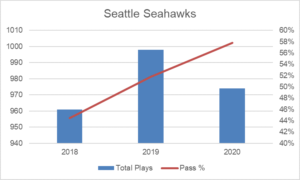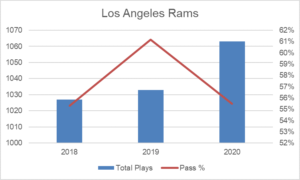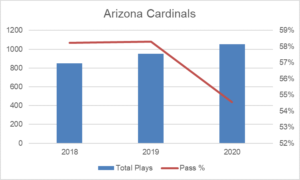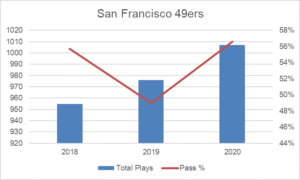NFC West 2020 Team Stats Review
Those who have followed my writing throughout the 2020 season will know that I’m a projections guy, I released weekly content highlighting key facts and stats about play volume, pass/rush tendencies, Vegas lines, target leaders, etc – my Projections Retrospective.
GET THE ALL-NEW YARDS PER FANTASY APP!
Now that 2020 has drawn to a close, I’ll be spending some time reviewing the total season numbers. The goal, to be more informed about what each team did so we can better project how they’ll tackle 2021 (subject of course to coaching and personnel changes over the offseason).
If you missed it, check out my Projections Guide where I looked at some of the key league-wide numbers for 2020 and stepped through how to create your own projections.
Let’s dive in to the NFC West.
Seattle Seahawks
A spike in 2019 regressed back down in to the bottom 10 in total play volume in 2020. This is what the Seahawks like to do, control the clock. The increase in passing ratio reflects the impacts of Lockett and Metcalf in the receiving corps and the missed time from Carson, allowing Russ to cook early in the season. This declined as the season went on but still represented an increase from 2019.
Seattle Seahawks Team Profile

What a potent 1a and 1b attack that was, with Metcalf’s superior aDOT (average depth of target) and YAC (yards after catch) giving him the overall edge over Lockett. Despite issues with Lockett’s lack of fantasy returns during parts of the season, his targets were consistently there. However, his aDOT and YAC came right down, as did his red zone targets (Lockett didn’t receive a target inside the 10 after week 8). The lead running back (Chris Carson for the most part) was still utilised in the passing game and the tight end room was very much a committee approach.

Chris Carson is first man up but he’s struggling to stay off the injury report for a long enough period to pay dividends. Even when he was fit, he only got more than 60-percent of carries twice all season. Carlos Hyde didn’t hit that mark and Deejay Dallas hit it once when he was last-man standing. Red zone usage was more interesting, with the lead back getting most or all of the carries in any given week. The general workload may have been split but the red zone usage wasn’t.
Key Takeaway: Is Russ going to cook or not? This is a run-heavy team with a concentrated passing attack. Metcalf is a beast that can turn those targets in to points with ease. I’m staying clear of Carson, Seattle aren’t leaning in to a workhorse back and with Penny hopefully getting a run of games under his belt, Carson’s workload is hard to trust.
Los Angeles Rams
The Rams volume is fairly stable and predictable. There’s a jump in 2020 but when you scratch the surface it’s all driven by one game in which they ran 90 (!) plays. They’re a run-first offense that struggled on the ground in 2019 but recaptured their form in 2020.
Los Angeles Rams Team Profile
This receiving corps shows a couple of tandem pairs. At wide receiver Kupp and Woods have remarkably similar numbers across the board, and at tight end it’s a similar story for Higbee and Everett. The differentiator in each case is the red zone targets. Josh Reynolds and Van Jefferson combined to be the deep threat with higher aDOT (average depth of target) and lower efficiency. Running back usage in the passing game was somewhat limited.
The backfield split that you see on the summary does not tell the story. Injuries on and off throughout the season saw different backs getting different workloads but a few things are clear. Firstly, Malcolm Brown is absolutely the third man up, rarely getting the bulk of carries in a game. Secondly, Darrell Henderson had his opportunity and didn’t take it. He had a couple of chances to dominate the backfield and after that it was clear that they didn’t want him having a dominant share. Finally, Cam Akers took hold of this backfield in week 13. From weeks 13-15, Akers had 76-percent of the workload. It’s his backfield now.
Key Takeaway: Remember the Rams that got to the Superbowl with Todd Gurley running all over defenses? That’s what this team wants to do and Akers has become the man who will do it.
Arizona Cardinals
Arizona has been on the increase since Kliff Kingsbury came to town. In 2019 they were one of the fastest paced teams in the league and that translated to a further increase in plays in 2020. The passing ratio came down as Kyler’s rushing increased, with the lowest pass ratio games being the ones where Kyler had the most rush attempts.
Arizona Cardinals Team Profile
DeAndre Hopkins is the alpha receiver and was absolutely dominant in this receiving attack. Outside of him, the air raid offense saw short targets to Larry ‘father time’ Fitzgerald and then deep shots to just about everyone else. Christian Kirk was an intriguing option but needs to be taking some of Hopkins’ volume in the area of the field where he’s targeted before he becomes a really solid option. Where Kirk can return value is in the red zone where he was targeted as much as Hopkins.
Not a workhorse workload but Drake was the main back and was only threatened by Edmonds on a few occasions. It’s Kyler Murray who takes away from the rushing volume and a large portion of the red zone usage, that’s a big hit to Drake’s ceiling. Drake does have the bigger share of the red zone looks but 9 of those 21 attempts inside the five came in only two games.
Key Takeaway: Don’t fade an elite wide receiver just because he changed teams! Kyler Murray caps the upside of whoever is at running back and there’s a potential opportunity for short-area targets if Fitzgerald retires.
San Francisco 49ers
An increase in play volume and passing ratio comes as the 49ers were a lot less competitive than in their 2019 Superbowl run. They’re still a run first team that likes to burn the clock but were often unable to do so this season.
San Francisco 49ers Team Profile

There wasn’t a high volume receiver in this team but then it was decimated by injuries throughout the season (Kyle Juszczyk was the only player to play in and get a target in every game). Aiyuk’s dominant share came when both Kittle and Samuel were out towards the end of the season. In the four games where Aiyuk, Kittle and Samuel were all available, Kittle had 30-percent target share, Samuel had 17-percent and Aiyuk had 16-percent. It is worth noting this was in the middle of the season before Aiyuk stamped his mark.
In terms of usage, while Aiyuk is just as capable of the low aDOT (average depth of target) / high YAC (yards after contact) targets it was Samuel’s usage that was almost exclusively this way, while Aiyuk had much more of the mid-range targets that are synonymous with a number one receiver.
It’s a mess of multiple backs and injuries all over the place. But if you start to pull apart the knots then there’s a few things we can take away. In 11 of 15 games, there was a running back with at least 14 carries. In six of those games, there was a running back with at least 16 carries.
If you work through the weeks and the carry leader in each, there’s a pecking order. Mostert was first in line, Coleman got the next go, before McKinnon was given a couple of games. That experiment failed as they then bounced to Wilson who promptly got injured after one game. Hasty was given a go but failed to capitalise so McKinnon jumped back above him in the pecking order. With Mostert back from injury towards the end of the year, he again was first in line followed by Jeff Wilson.
Put it another way, thanks to injuries everyone got a chance to become the lead back and most of them failed to capitalise (Coleman, McKinnon, Hasty). Mostert and Wilson came out of the mist with the ball in their hands and promptly shared the workload between them towards the end of the season.
Key Takeaway: With so many injuries we haven’t been able to see how this offense looks with everyone in it, so understanding the roles of each player and the pecking order is going to be critical to predicting production for 2021.















